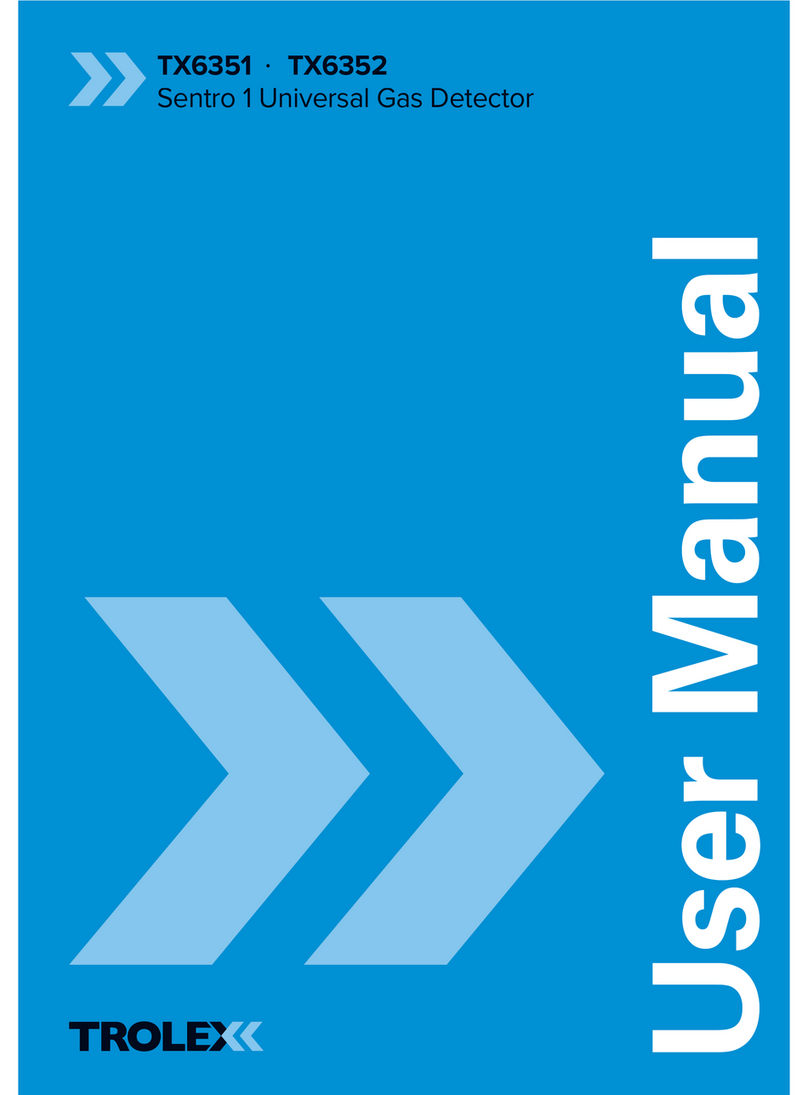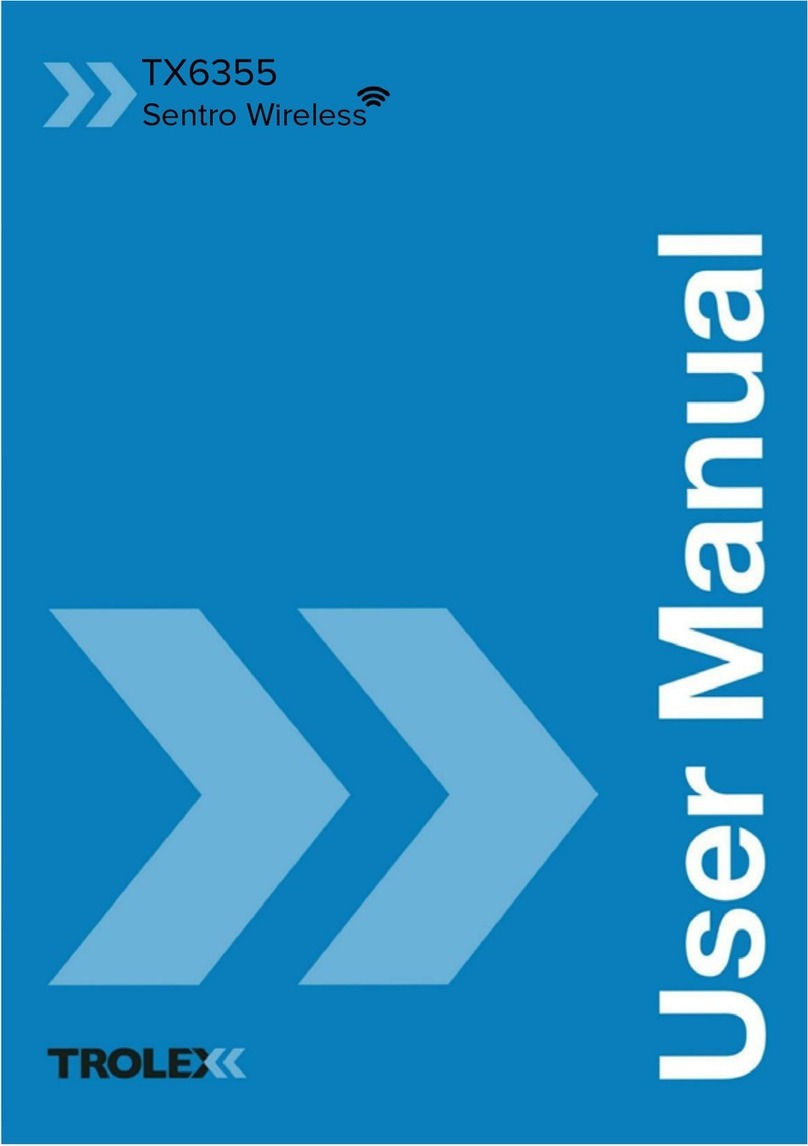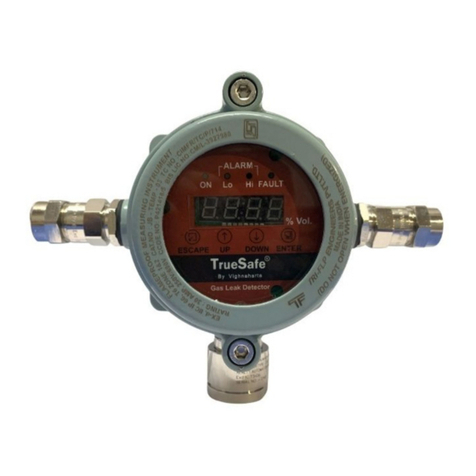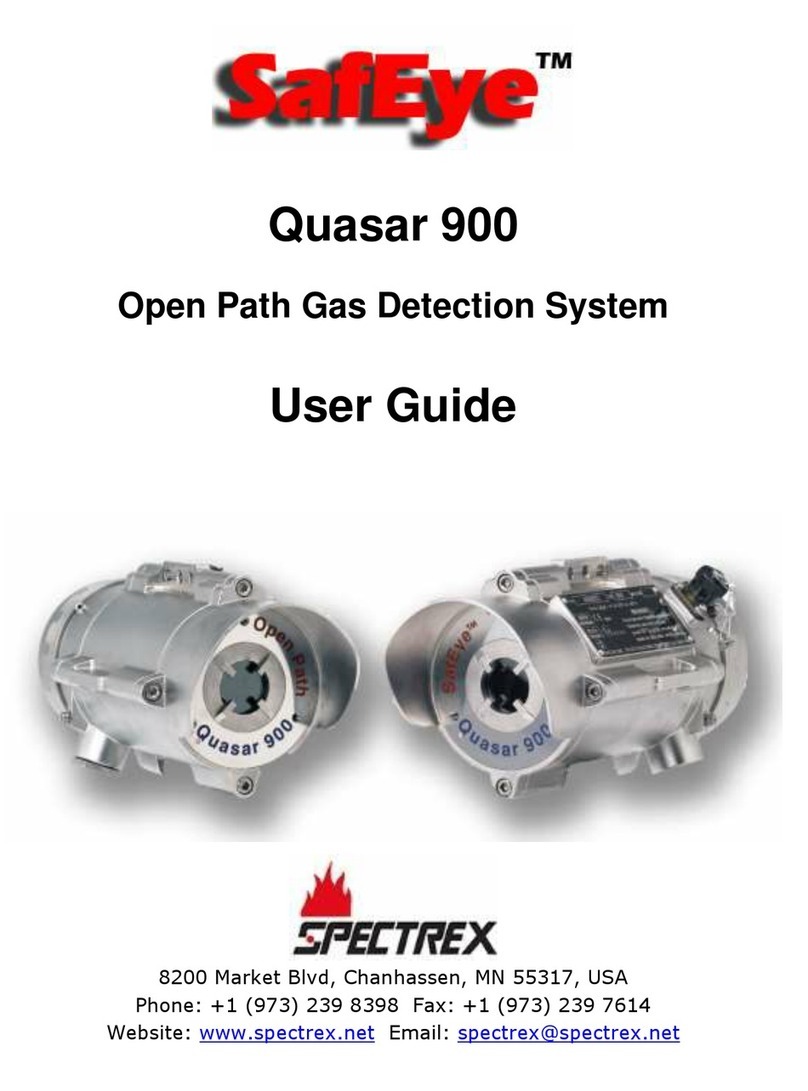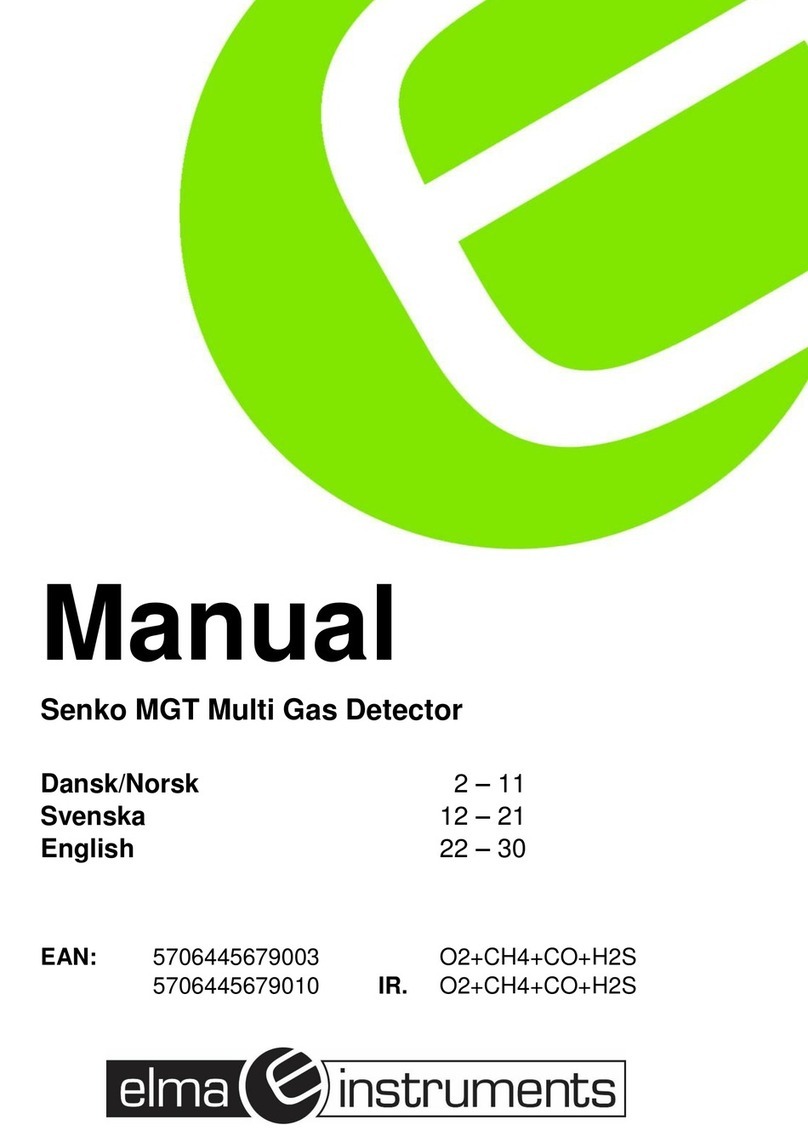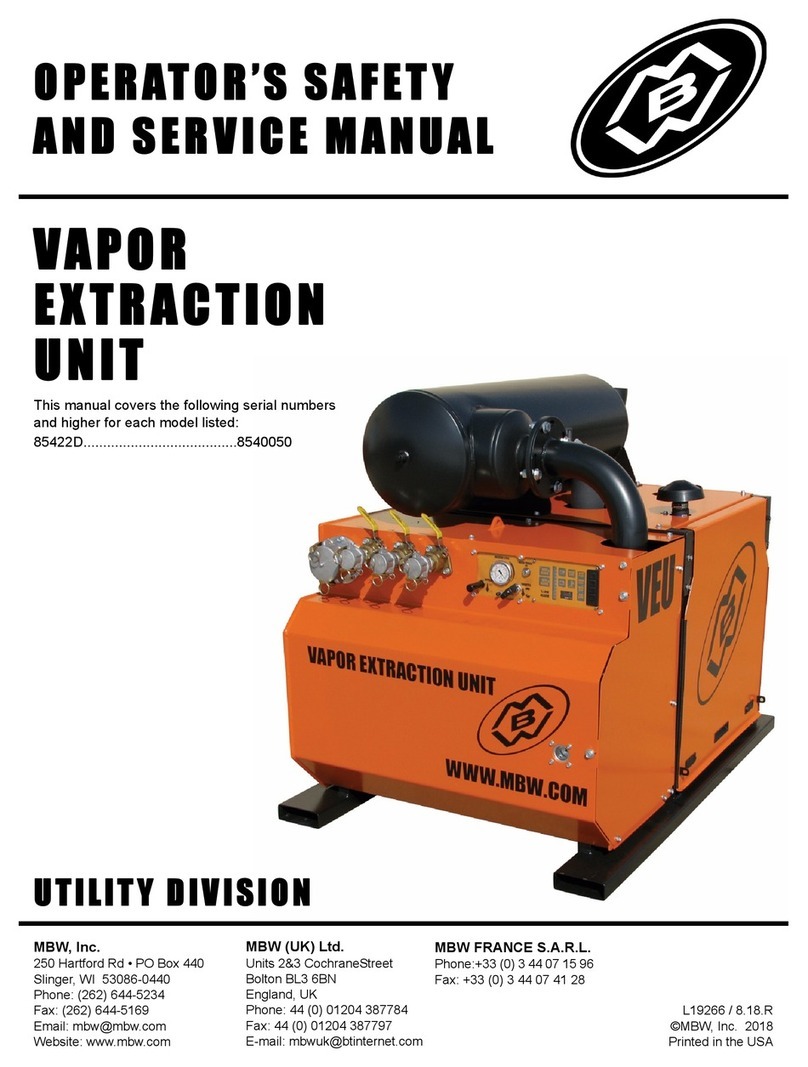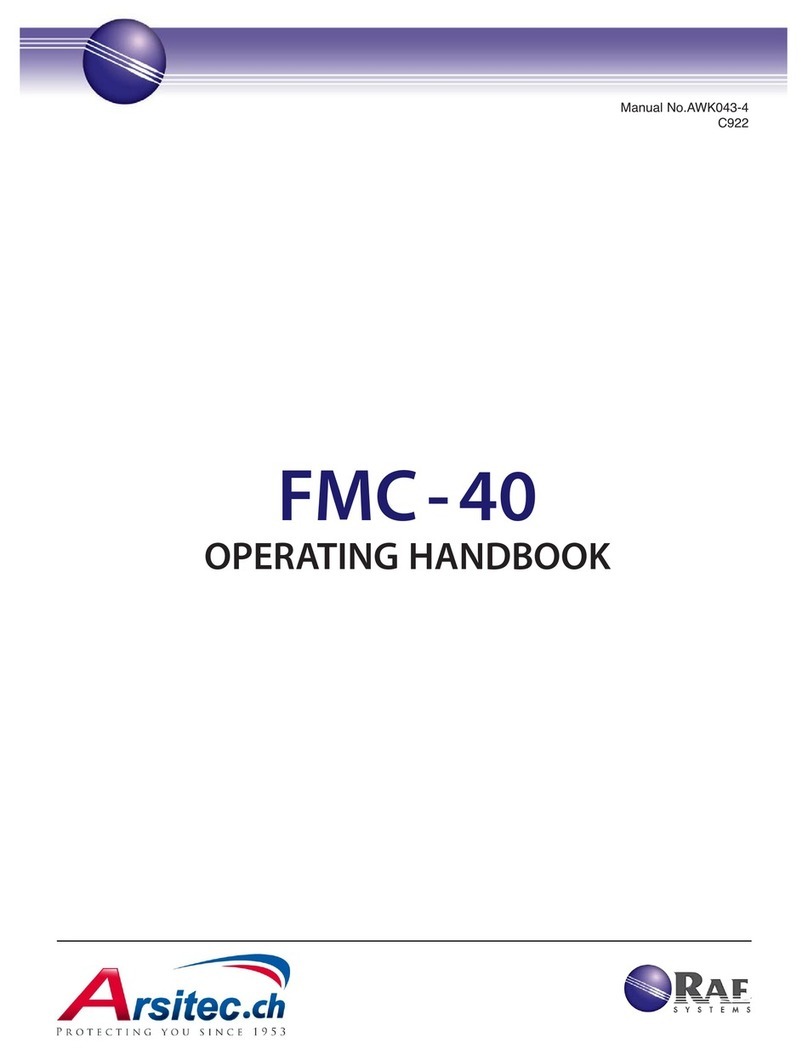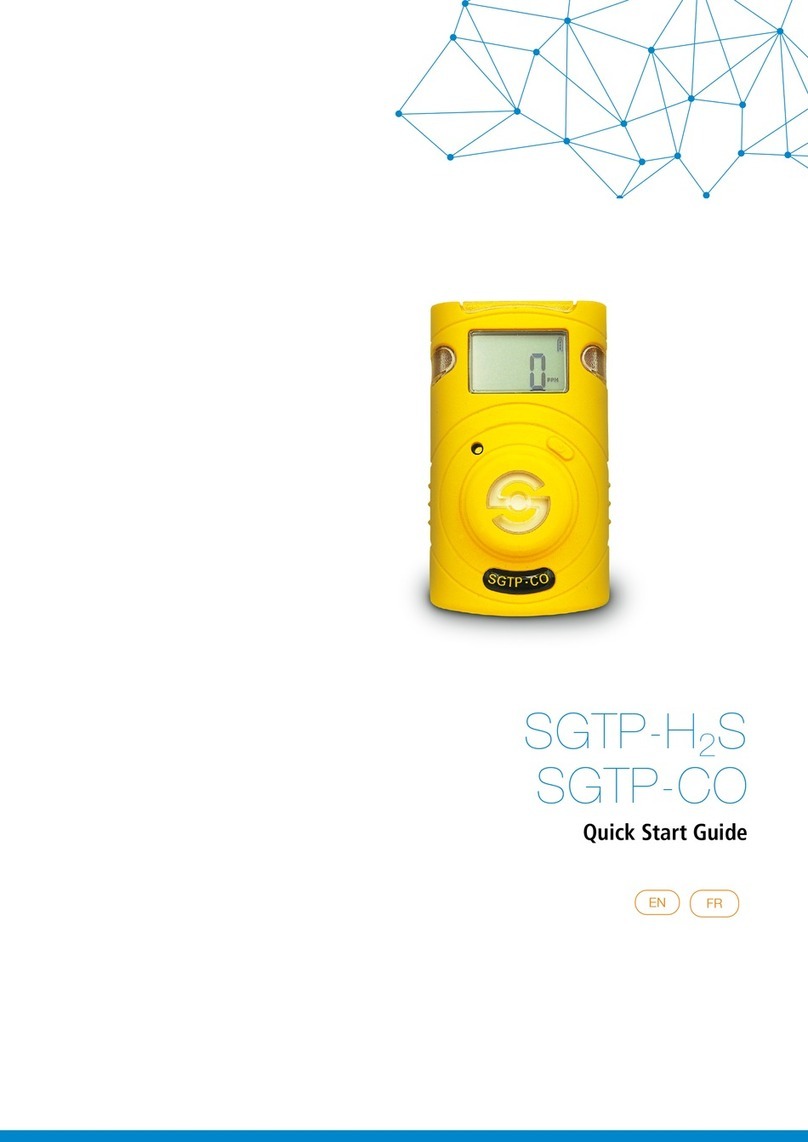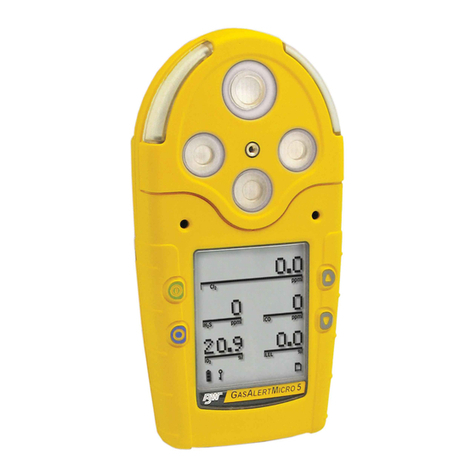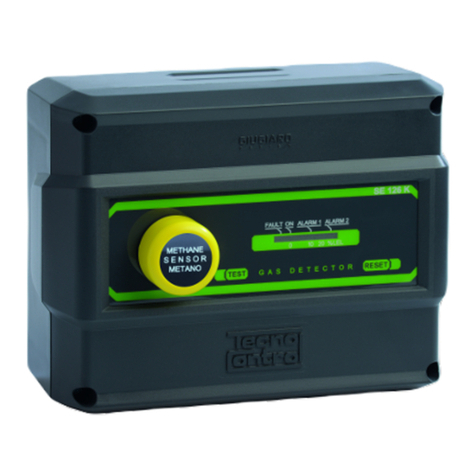Trolex TX6373 User manual

INSTALLATION &
OPERATING DATA
contents...
page
1PRINCIPAL OPERATING FEATURES 2
2APPLICATION 3
3DIMENSIONS AND MOUNTING 4
4TECHNICAL DETAILS 4
5INSTALLATION 6
6CONNECTIONS 10
7CONTROLS AND INDICATORS 13
8CALIBRATION 14
9MAINTENANCE 17
10 APPROVALS AND CERTIFICATION 20
PETROCHEMICAL
PROCESSING
MINING&
TUNNELLING
OFFSHORE
PLATFORMS
MANUFACTURING
& PROCESS
PLANTS
STORAGEAREAS&
WAREHOUSING
WATER
MANAGEMENT
&SEWAGE
TREATMENT
POWERGENERATION
GAS STORAGE &
DISTRIBUTION
TELECOMMS
TX6373
TOXIC GAS SENSOR/TRANSMITTER
1/25
ISSUE N 06/15
11 FUNCTIONAL SAFETY 22

INSTALLATION & OPERATING DATA
Stationary gas sensors for the detection of a wide range of
toxic gases.
Suitable for use in SIL 1 and SIL 2 applications, in accordance with
any conditions or restrictions.
High accuracy electrochemical sensing elements.
Pre-calibrated plug-in gas sensing module with a
standardised output signal for convenient replacement and
servicing.
Calibration available for a wide range of toxic gases.
Convenient push button calibration of ZERO and SPAN.
Signal fix during calibration to prevent false alarms - 4 wire
systems only
Output signal versions:- 4 to 20 mA, 0.4 to 2 V & 5 to 15 Hz
Anti-static polycarbonate/ABS housing.
Intrinsically safe for use in Group I and Group II hazardous areas.
Optional format with remote mounted gas sensing
module in robust metal housing.
1 PRINCIPAL OPERATING FEATURES
2/25
ISSUE N 06/15

INSTALLATION & OPERATING DATA
Fixed gas monitoring for point-source hazards and perimeter
protection in arduous duty and exposed locations.
Safety protection for toxic gas risk occurring in hazardous areas and
general industrial applications.
Petrochemical processing.
Mining and tunnelling.
Offshore platforms.
Manufacturing and process plants.
Storage areas and warehousing.
Water management and sewage treatment.
Power generation.
Gas storage and distribution.
Telecommunications.
A choice of output signals for direct interfacing with most
standard industrial monitoring systems.
2 APPLICATION
TRIP AMPLIFIER
for use with analogue output sensors.
CONFIGURABLE SENSOR CONTROLLER
for monitoring up to
8 analogue output sensors.
COMMANDER DISTRIBUTED I/O SYSTEM
for large scale general plant
monitoring systems and the mining
and tunnelling industries.
A range of primary instrumentation and monitoring modules
is available from Trolex to which the sensors can be directly
connected to provide a flexible choice of display and
control functions.
3/25
ISSUE N 06/15

INSTALLATION & OPERATING DATA
3 DIMENSIONS
ALL DIMENSIONS IN MM
4 TECHNICAL DETAILS
4.1 Specification
Ambient Temperature Limits: –10°C to +50°C
Storage Temperature Limits: –20°C to +60°C
Ambient Pressure Limits: Atmospheric ± 10%
Humidity: 90% RH non-condensing
Protection Classification: Dust and waterproof to IP66. Gas inlet port to IP54
Housing Material: Anti-static polycarbonate/ABS
Nett Weight: 450 g
Cable Entries: M20 x 1.5
Electrical Connections: 4 mm Barrier/clamp terminals
Information Display: Graphic LCD
Impact Limits: 20 joules (Housing)
Calibration: Digitally controlled ZERO and SPAN. Push button setting
Signal Fix: The transmitted output signal of the sensor is FIXED at 00.0
during calibration to prevent false alarms from being initiated
110
97
63
26
100 148
64
38
Ø10
Ø6.5
Gas Entry Port
3 Cable Entries to
Suit M20 Glands or
Multi Pole Connector
2 Holes for
M6 Socket
Cap Head
Fixing Screws
External Earth Terminal
110
97
2000 (standard)
148
External Earth Terminal
2 Holes for
M6 Socket
Cap Head
Fixing Screws
124.0
15.0
26.0
3.1 TX6373 Toxic Gas Sensor/Transmitter 3.2 TX6373.84 Toxic Gas Sensor/Transmitter
with Remote Gas Sensing Module
METHANE CATALYTIC COMBUSTION
ELECTROCHEMICAL SENSING LINEARITY DRIFT REPEATABILITY RESPONSE OPERATING ORDER
Carbon Monoxide 0 to 50 ppm ±2% FS 2% month ±2% 9 secs >2 years (250.50)
0 to 250 ppm (250.250)
0 to 500 ppm (250.500)
Hydrogen Sulphide 0 to 50 ppm ±2% 2% month ±2% 14 secs >2 years (251)
Sulphur Dioxide 0 to 20 ppm ±2% 2% month ±2% 7 secs >2 years (252)
Nitrogen Dioxide 0 to 20 ppm ±2% 2% month ±2% 15 secs >2 years (254)
Chlorine 0 to 10 ppm ±2% 2% month ±2% 37 secs >2 years (255)
Oxygen 0 to 25% ±5% 10% year ±2% 5 secs >1 year (257)
Nitric Oxide 0 to 100 ppm ±5% 2% month ±2% 9 secs >2 years (259)
Hydrogen 0 to 1000 ppm ±1% 2% month ±2% 13 secs >2 years (261)
*IN CLEAN AIR
2 Fixing holes
for M6 Socket
Cap Head Screws
2 Holes for
M6 Socket
Cap Head
Fixing Screws
SENSOR RANGE TIME T63% LIFE*REF
4/25
ISSUE N 06/15

INSTALLATION & OPERATING DATA
4 TECHNICAL DETAILS continued
4.2 Electrical Details
20 mA
4
2 V
0.4
15 Hz
5
TX6373.01 GROUP I APPLICATIONS (12 V dc)
20 mA
4
TX6373.02 GROUP II APPLICATIONS (24 V dc)
When used in conjunction with safety barriers. (Section 6)
20 mA
4
TX6373.03 GENERAL PURPOSE APPLICATIONS (24 V dc)
Output: 0.4 to 2 V dc
Min Load 10 k ohms
Supply 6.5 to 16.5 V dc
Max Current <10 mA
Output: 5 to 15 Hz
Max Load Opto isolated
. 2 mA max
Supply 6.5 to 16.5 V dc
Max Current <20 mA
Output: 4 to 20 mA
Max Load 875 ohms @ 24 V dc
Supply 6.5 to 30 V dc
Max Current 24 mA
Output: 4 to 20 mA
Max Load 875 ohms @ 24 V dc
Supply 6.5 to 30 V dc
Nominal Current 24 mA
Refer to Section
6
Output: 4 to 20 mA
Max Load 275 ohms @ 12 V
Supply 6.5 to 16.5 V dc
Max Current 24 mA
5/25
ISSUE N 06/15

V
INSTALLATION & OPERATING DATA
(Refer to Test Certificate provided with the sensor).
Does the output signal of the sensor concur with the input
requirement of
the monitoring equipment being used?
Is the correct supply voltage available for the sensor?
Is the type of gas and its anticipated maximum level of
concentration, within the operating parameters of the sensor?
Is the temperature variation range, at the installation, within the
stated temperature range of the sensor?
Is the hazardous area classification correct?
If the hazard is Group II – are the correct safety barriers fitted?
5 INSTALLATION
A
20 mA
4
2 V
0.4
Hz
15 Hz
5
12 V dc 24 V dc
GROUP I GROUP II
GENERAL
PURPOSE
5.1 Conformity Check
TX6373.01 TOXIC GAS SENSOR/ TRANSMITTER GROUP I
TX6373.02 TOXIC GAS SENSOR/ TRANSMITTER GROUP II
TX6373.03 TOXIC GAS SENSOR/ TRANSMITTER GENERAL
PURPOSE
TX6373.84.01 TOXIC GAS SENSOR/ TRANSMITTER GROUP I
with Remote Gas Sensing Module
TX6373.84.02 TOXIC GAS SENSOR/ TRANSMITTER GROUP II
with Remote Gas Sensing Module
TX6373.84.03 TOXIC GAS SENSOR/ TRANSMITTER GENERAL
with Remote Gas Sensing Module PURPOSE
0.4 to 2 V (11)
4 to 20 mA (12)
5 to 15 Hz output (13)
S
ST
TA
AN
ND
DA
AR
RD
DO
OP
PT
TI
IO
ON
NS
SA
AV
VA
AI
IL
LA
AB
BL
LE
E
Refer to Section
4. 2
TYPE OFGAS
OUTPUT SIGNAL
6/25
ISSUE N 06/15

INSTALLATION & OPERATING DATA
5.2 Location
Each installation needs to be considered in its own right, with reference to safety
authorities and in compliance with mandatory local safety regulations. The sensor
must be operated in accordance with the Installation and Operating Data to maintain
safety, reliability and to preserve Intrinsic Safety integrity where applicable.
It is important that sensors are located in positions determined in consultation
with those who have specialised knowledge of the plant or installation and of the
principles of gas dispersion. Reference should also be made to those responsible for
the engineering layout and topology of the plant as they will be most familiar
with the nature of the potential dangers and the most likely sources of gas release.
It is also important to recognise that the characteristics of the gas source can be
influenced by many factors; including the relative density or buoyancy of the gas,
the pressure at the point of release, the ambient temperature and the ventilation
of the site.
Sensor coverage cannot be simply expressed in terms of ‘number per unit area’.
Sensors need to be sited where they are capable of monitoring those parts of a
plant where gas may accumulate or when a source of gas release is expected
to occur. This way the earliest possible warning of a gas release can be given to
initiate shutdown functions, alarm functions or safe evacuation of the premises.
5.3 System Integrity
If a gas monitoring system should fail for any reason, it is important that the system is
capable of immediately alerting operational staff to this fact. The sensor will indicate
a system failure or mechanical defect and this information can be utilised to initiate a
warning alarm. It is good practice to provide emergency facilities to protect against
the loss of the mains power supply.
Standby batteries can be incorporated with automatic changeover facilities, so
guaranteeing continued operation of the gas sensing system even in the event of
a plant breakdown as a result of a power supply failure.
Certainly, in critical plants, duplication or triplication of sensors is recommended.
The Trolex TX9042 or TX9044
Programmable Sensor Controller
can be programmed to operate
with sensors in the multiple
voting mode.
5.4 Sensor Management
A very important part of an efficient gas monitoring system is the training of plant
personnel in operation and maintenance of the sensors and the complete
monitoring system. Training facilities can be provided by qualified Trolex application
engineers.
Once a sensor installation is complete, the sensor locations and types should be
formally recorded and a planned test and maintenance procedure instituted.
5 INSTALLATION continued
7/25
ISSUE N 06/15

Hydrogen
LIGHTER THAN AIR
Carbon Monoxide
Nitric Oxide
Oxygen
Sulphur Dioxide HEAVIER THAN AIR
Chlorine
Nitrogen Dioxide
INSTALLATION & OPERATING DATA
5 INSTALLATION continued
5.5 Relative Density
The relative density or buoyancy of the gas or vapour with respect to air is a very
important consideration. This determines its propensity to rise or
fall
when
released into the atmosphere.
Gases or vapours with a buoyancy less than air will tend to rise from the source
of release.
Conversely, gases or vapours heavier than air will tend to fall and accumulate in
concentrations for long periods of time.
This is a particular problem in pits, trenches, machine rooms, etc. Normal air
movements in and around such gas concentrations will have the inevitable
effect of producing zones of highly toxic mixtures.
This knowledge of the characteristics of the gas assists when positioning the gas
sensor.
The behaviour of the gas accumulation will also be affected by the velocity and
location of the gas release and by ambient air movement caused by ventilation
systems or draughts.
Pockets of gas can be trapped in trenches or ceiling cavities, all of which adds to
the unpredictability of critical gas concentrations.
5.6 Hazardous Areas
Do not disassemble the sensor whilst in the hazardous area or use a sensor
that has a damaged housing in the hazardous area.
5.7 Evacuation
If a dangerous level of gas concentration is detected by the instrument, leave
the area immediately.
8/25
ISSUE N 06/15

INSTALLATION & OPERATING DATA
5 INSTALLATION continued
5.8 Operating Life
Electrochemical cells contain an electrolyte that is gradually consumed during
use. The average life is about two years, dependent upon the duty cycle.
The response should be checked at regular intervals.
5.9 Sensitivity
Electrochemical cells for toxic gases can be affected by other interfering
gases which may displace the subject gas being monitored. Steam laden
atmospheres and condensation can also reduce the sensitivity.
5.10 Flammable
Be aware that some toxic gases are also ‘flammable’ at high percentage
concentrations.
5.11 Biased Sensors
Some gas sensors must be continuously powered to maintain the calibration.
If the gas head is removed from any supply voltage for greater than 10 minutes,
it could take 24–48 hours to restore its calibration.
9/25
ISSUE N 06/15

1 2 3 4 5
TX6373
+ V Supply
67 8
0 V Supply
TX9132
1 2 3 4 5
TX6373
+V Supply
67 8
TX9132
6.1 0.4 to 2 V Output Signal
A low impedance two-wire voltage
output signal requiring a separate
power supply to the sensor.
This can be derived from a TX9132
Trip Amplifier or TX9042 Programmable
Sensor Controller, when one of those is used
as the monitoring instrument.
This connection configuration works well up to about
2000 metres distance between the sensor and the monitoring
equipment.
Both the signal and the power supply to the sensor are being
carried in the common 0 V conductor so at some point –
influenced by the length of the cable and the resistance of the
cable cores – the current flowing in the 0 V conductor will impose
an unacceptable voltage error onto the signal.
This effect can be reduced on long distance connections by
increasing the size of the cable cores, or even better, running a
separate 0 V conductor to power the sensor enabling operating
distances up to 5000 metres.
INSTALLATION & OPERATING DATA
6 CONNECTIONS
TX6373 TOXIC GAS SENSOR/ TRANSMITTER
2- WIRE CURRENT LOOP OPERATION
3 WIRE
4 WIRE
V2 V
0.4
OUTPUT SIGNAL OPTIONS
1 2 3 45
Signal
0V Supply
6 7 8
0 V
+ V
1 2 3 45
Signal
Supply
6 7 8
TX6373 TOXIC GAS SENSOR/ TRANSMITTER
4- WIRE OPERATION
10/25
0.4 to 2 V signal
0 V
0.4 to 2 V signal
0 V
APPLICATION GROUP I HAZARDOUS AREAS
ISSUE N 06/15

6.3 5 to 15 Hz Output Signal
A square wave, frequency variable
output that is proportional to the
measured value. The output device
is an open collector NPN transistor.
Output: 5 to 15 Hz
(zero = 5 Hz)
(span = 15 Hz)
Maximum Voltage: 15.4 V
Maximum Current: 2 mA
Minimum Pulse Rise Time: 5 V/ms
1 2 3 4 5
TX6373
+V
4 to 20 mA signal
67 8
TX9031
6.2 4 to 20 mA Output Signal
The output signal from terminals
1 and 4 is a conventional 4 to 20 mA
two wire current regulated signal loop.
Electrochemical sensors have very low
power consumption so the same loop
can be used to also power the sensor.
No separate power supply is needed.
INSTALLATION & OPERATING DATA
6 CONNECTIONS continued
2 WIRE A20 mA
4
1 2 3 5 678
4
0 V
5 to 15 Hz signal
+ V Supply
0 V Supply
TX6373
Monitoring
Device
A pull up resistor may be required
at the monitoring device.
6.4 Using Gas Sensors in Hazardous Areas
6.4.1 GROUP I HAZARDOUS AREAS (MINING)
TX6373.01 TOXIC GAS SENSOR/ TRANSMITTER
All options of the TX6373.01 sensor (0.4 to 2 V, 4 to 20 mA and
5 to 15 Hz) are certified Intrinsically Safe for use in Group I
hazardous areas (Mining) when used with approved equipment
eg. TX9131 Trip Amplifier or a TX9042 Programmable
Sensor Controller.
THE COMPLETE SYSTEM, BOTH SENSOR AND MONITORING
DEVICE, CAN BE MOUNTED IN THE HAZARDOUS AREA.
The interconnecting cable between the sensor and the
monitoring device must have steel wire armoured
protection or a braided earth screen. The cross sectional
area of the conductors must be a minimum of 1 mm2.
TX9131
HAZARDOUS
SAFE
TX6373.01
Hz
15 Hz
5
11/25
APPLICATION GROUP I HAZARDOUS AREAS
GROUP II HAZARDOUS AREAS
GENERAL PURPOSE
APPLICATION GROUP I HAZARDOUS AREAS
ISSUE N 06/15

INSTALLATION & OPERATING DATA
6 CONNECTIONS continued
6.4.2 GROUP II HAZARDOUS AREAS (24 V dc)
TX6373.02 TOXIC GAS SENSOR/ TRANSMITTER
This version of the sensor (4 to 20 mA) is certified Intrinsically
Safe for use in Group II hazardous areas, when used in
conjunction with safety barriers.
THE SAFETY BARRIERS ARE MOUNTED IN THE SAFE AREA,
ONLY THE SENSOR IS MOUNTED IN THE HAZARDOUS AREA.
The system may be used with either zener safety barriers or
isolation safety barriers.
4 to 20 mA
Signal
HAZARDOUS SAFE
TX6373.02
Group II sensor connections using zener safety barriers.
NB: IS EARTH MUST BE LESS THAN 10 OHMS LOOP RESISTANCE
Max. Cable Length: 1 km using 1.5 mm2cable conductors.
If you require any help with the use and connection of hazardous area equipment
please contact the Trolex Technical Department.
Signal Safety Barrier: MTL787S+
1 2 3 4 5 6 7 8
1
2
4
3
MTL 787S+
+V +V
Signal
HAZARDOUS SAFE
TX6373.02
Group II sensor connections using isolation safety barriers.
Max. Cable Length: 1 km using 1.5 mm2cable conductors.
Signal Isolation Barrier:
Pepperal & Fuchs
KFD2–CR–EX 1.30–300
1 2 3 4 5
Supply
67 8
1
2
8
7
3
11
12
KFD2–CR–EX 1.30–300
0V
+V
Signal
HAZARDOUS SAFE
TX6373.02
LED sequence on power-
up Power up:
Red LED flashes 3 times
Normal Operation:
No LEDs illuminated
12/25
+V
0V
ISSUE N 06/15

INSTALLATION & OPERATING DATA
Plug-in Gas
Sensing Module
Cable Entry
Gas Concentration
Display
Earth
Terminal
Gas Entry Port
7 CONTROLS AND INDICATORS
TX6373 TOXIC GAS SENSOR/ TRANSMITTER
GCalibration STATUS indicator
SPAN calibrate pushbutton
ZERO calibrate pushbutton
TX6373.84 TOXIC GAS SENSOR/ TRANSMITTER REMOTE GAS SENSING MODULE.
This version uses the same pre-calibrated gas sensing module as the TX6373. The
module is fitted into a robust metal housing which can be mounted at a
remote location where space is constricted or the operating conditions are
extremely harsh.
Connections: 2 metres, flexible cable in a flexible armoured conduit
(other lengths available to specification - max. of 10 m)
Protection Classification: Dust and waterproof to IP66
Housing Material: Brass or Stainless steel
Maximum Cable Length: Extendible up to 250 m using 1.5 mm2cable conductors
DISCONNECTING THE REMOTE GAS SENSING MODULE
The connecting cable between the remote gas sensing module
and the Transmitter is normally supplied connected at both ends.
The cable can be disconnected via a plug and socket connector
inside the Transmitter housing for servicing or transportation.
Secure connector to
inside of the enclosure
with a double sided
adhesive foam pad.
(Trim off any excess
before fitting).
Double line
indicates red marker
on ribbon cable.
I
IM
MP
PO
OR
RT
TA
AN
NT
T!
!
The Ribbon Cable
Assembly must lie flat
against the inside rear
of the enclosure &
must be connected to
the feed through in the
orientation shown.
View showing
orientation of
ribbon cable.
(All other parts
removed for clarity).
13/25
ISSUE N 06/15

R
INSTALLATION & OPERATING DATA
8 CALIBRATION
The gas sensing module will gradually change its response
characteristics, by a small amount, during normal use.
The output signal is standardised so the module can be
quickly changed when necessary.
Ser vice replacement modules can be
supplied by our Product Support
Department.
Alternatively the gas sensing module
may be re-calibrated when required,
using a Trolex TX6520 Gas Test Kit
equipped with both Air and
Test Gas canisters.
8.1 Prepare to Calibrate
Connect the application tube of the gas test kit to the
inlet aperture of the gas sensing module.
8.2 Enter Calibrate Mode
Press BOTH pushbuttons on the gas
sensing module for about 5 seconds.
Then release.
The indicator will be RED denoting that the
module is now setup ready for:
When the Gas Sensing Module is
setup into the CALIBRATE MODE it
will instruct the transmitted output
signal of the sensor to be FIXED at
a value of 0.00. This will prevent the
possibility of false alarm signals being activated in the
monitoring equipment during the calibration process.
The display will continue to show the measured value of
gas concentration during the calibration process.
This function is not operational on 4 to 20 mA, 2 wire systems.
Refer to Section
8.3
Calibrate ZERO
OR
Calibrate SPAN
Refer to Section
8.4
FIX
0
14/25
ISSUE N 06/15

INSTALLATION & OPERATING DATA
8 CALIBRATION continued
8.3 Calibrate ZERO
Apply purge air, at a flow rate of 0.2 to 1 l/min, for a few
seconds to clear all remnants of gas.
AIR
The Gas Sensing Module will automatically return to
the NORMAL measuring mode if NO pushbuttons are
operated within 60 seconds.
Press CALIBRATE ZERO (5 seconds) until the indicator is flashing
GREEN (3 times).
Release and the indicator will briefly show RED to denote
ZERO setup.
The Gas Sensing Module will commence auto-zero.
Once the auto-zero has completed, the indicator will briefly
show amber to indicate trim mode has been entered.
G
G
R
G
TRIM MODE
Trim mode allows the output from the GSM to be adjusted to
give an accurate 'zero' level. During this mode, the CALIBRATE ZERO
button decreases the output signal and the CALIBRATE SPAN
increases it. Once set, the GSM will return automatically to
normal mode about 25 seconds after the last button press.
15/25
ISSUE N 06/15

INSTALLATION & OPERATING DATA
8 CALIBRATION continued
8.4 Calibrate SPAN
Apply test gas, at a flow rate of 0.2 to 1 l/min, for a few seconds
until the display value stabilises.
The Gas Sensing Module will automatically return to
the NORMAL measuring mode if NO pushbuttons are
operated within 50 seconds.
Press CALIBRATE SPAN (5 seconds) until the indicator is flashing
YELLOW (3 times).
(SPAN CALIBRATION will not occur if an insufficient
concentration of span gas is present).
SCROLL the display value UP/DOWN until it concurs with the
value of gas concentration marked on the test gas canister.
50 seconds after SCROLLING has ceased the gas sensing
module will automatically return to the NORMAL measuring
mode.
TEST GAS
Y
Y
R
G
R
Keep the test gas applied for a few seconds to verify
the response of the sensor.
Switch off the test gas supply.
16/25
ISSUE N 06/15

It is good safety practice to carry out regular preventative maintenance to
confirm correct operation.
9.1 Output Signal
Check the response of the sensor at pre-determined intervals
by injecting a test gas using a Trolex TX6520.32 Gas Test Kit.
Compare the value of the display with the value marked on the
test gas canister.
9.2 Proof Test
Calibrate the TX6373 using the instructions in Section 8.
Insert an approved test meter into the signal line.
Inject a test gas using a Trolex TX6520.32 Gas Test Kit.
Compare the value on the test meter display with the measured
line value.
If the value on the test meter does not match the value on the display:
Recalibrate and then carry out the proof test again
OR
change the gas sensing module, calibrate and then carry out
the proof test.
9.3 Gas Sensing Modules
The gas sensing modules should be changed at regular intervals
to ensure accuracy of response.
Electrochemical cells contain an electrolyte that is gradually
consumed during use.
The average life is about two years, influenced mostly by duty
cycle, ambient temperatures and humidity. The shifting response of
the cell should be checked at regular intervals.
The modules are conveniently replaceable giving a pre-calibrated
standardised output signal. They can be changed in seconds.
Service replacement modules can be supplied by our Product
Support Department on a regular basis.
Simply insert the new module into the instrument and return the
original for checking and calibration.
INSTALLATION & OPERATING DATA
9 MAINTENANCE
LOCK
Refer to Section
8
Refer to Section
9. 2
AIR
CH4
AIR
CH4
RELEASE
The sensor will transmit a LOW alarm signal if a
replacement gas sensing module is not fitted
within 15 seconds
17/25
ISSUE N 06/15

INSTALLATION & OPERATING DATA
9 MAINTENANCE continued
9.4
Display
In addition to displaying the gas type and actual gas readings,
the display can indicate the status of the instrument.
Head Removal
If a gas sensing head is removed, the display will indicate this by
showing .
The output current will fall to about 1.5 mA for 2-wire systems. On
non-2-wire systems the output signal will remain fixed for
15 seconds and then down scale to about 3 mA.
If the head is replaced, then normal operation is resumed.
Underrange
If for any reason the signal from the head drops below the
normal baseline level (head failure for example) the display will
indicate . Once the underrange condition is cleared, then
the display will return to normal.
Overrange
If the gas sensing head ‘sees’ a gas concentration of 1% or more
above its full scale output, the display will indicate .
This mode may only be cleared by cycling the power.
9.5 Remove Gas Sensing Modules (TX6373.84)
Insert a bar into one of the radial holes in the gas inlet bush
(take care not to damage the internal filter) and unscrew the gas
inlet bush. Remove the filter from the gas inlet bush. Clean or
replace the filter as necessary. Fit a new or cleaned filter to the gas
inlet bush. Using a spanner, remove the sensor retaining nut from
the remote housing. Remove the gas sensing module from the
remote housing. Fit a new gas sensing module to the remote
housing, refit the sensor retaining nut and tighten. Refit the gas
inlet bush and tighten using a bar inserted into one of the radial
holes, taking care not to damage the filter.
9.6 Annual Safety Check
The main transmitter itself will not normally require maintenance or
calibration but it is advisable to return it to the Trolex Product
Support Department for an annual safety check.
9.7 Damaged Sensors
A Sensor that has been dropped or damaged in any way should
be taken out of service immediately for inspection, repair and
re-calibration.
9.8 Record Keeping
Institute a regular calibration and maintenance procedure and
keep a record.
Incorrect use of the Sensor or inadequate maintenance may
not necessarily be self evident in the Sensor and consequently
it must be regularly checked and maintained.
18/25
ISSUE N 06/15

INSTALLATION & OPERATING DATA
9.9 Maintenance and Calibration Log
ORDER REF TX6373 DATE SUPPLIED
SERIAL No. USER
GAS TYPE LOCATION
9 MAINTENANCE continued
DATE SCHEDULED FAILURE RE-CALIBRATE CHANGE GAS RETURN TO COMMENTS
SENSING
MANUFACTURER
MODULE
19/25
ISSUE N 06/15

INSTALLATION & OPERATING DATA
10 APPROVALS AND CERTIFICATION
10.2
Europe (ATEX)
TX6373.01.xx Toxic Gas Sensor / Transmitter (Group I)
Ex Certificate number: SIRA 02ATEX2052X
Ex Certification code: I M1 Ex ia I Ma (Ta = -20
°
C to +60
°
C)
TX6373.02.12 Toxic Gas Sensor / Transmitter (Group II)
Ex Certificate number: SIRA 02ATEX2052X
Ex Certification code: II 1G Ex ia IIC T4 Ga (Ta = -20
°
C to +60
°
C)
Special Conditions for Safe Use
When the TX6373 is specifically required for group II, category 1 equipment, the
TX6373 should not be installed in a location where the external conditions are
conducive to the build-up of electrostatic charge as the polycarbonate window may
store an ignition-capable level of electrostatic charge. Additionally, the equipment
should only be cleaned with a damp cloth.
General Conditions for Safe Use
Prior to installation, it is essential that user refers to the above certificate to ensure
that the termination and cable parameters are fully complied with and are
compatible with the application. Copies of certificates are available from Trolex.
ATEX Directive (94/9/EC)
Australia/New Zealand (ANZEx)
TX6373-series Toxic Gas Sensor / Transmitter
Ex Certificate Number: ANZEx 12.3016X
Ex Certification Code: Ex ia I (Ta = -20
°
C to +60
°
C)
Ex ia IIC T4 (Ta = -20
°
C to +60
°
C)
Special Conditions for Safe Use:
Prior to installation, it is essential that the user refers to the above certificate to
ensure that the termination and cable parameters are fully complied with and are
compatible with the application. Copies of certificates are available from Trolex.
When the TX6373 is specifically required for group II, Zone 0, the TX6373 should
not be installed in a location where the external conditions are conducive to the
build-up of electrostatic charge as the polycarbonate window may store an ignition-
capable level of electrostatic charge. Additionally, the equipment should only be
cleaned with a damp cloth.
10.1
20/25
ISSUE N 06/15
This manual suits for next models
6
Table of contents
Other Trolex Gas Detector manuals
Popular Gas Detector manuals by other brands
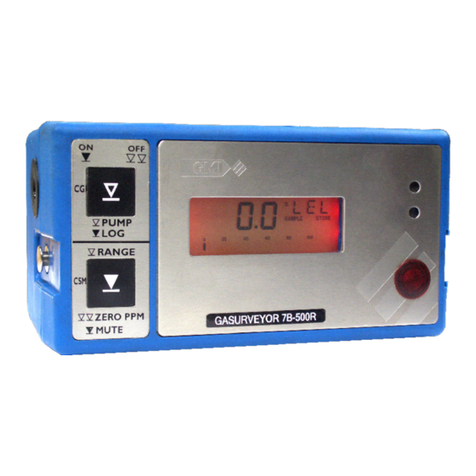
Teledyne
Teledyne GASURVEYOR 7B-500R Quick Operating Instructions
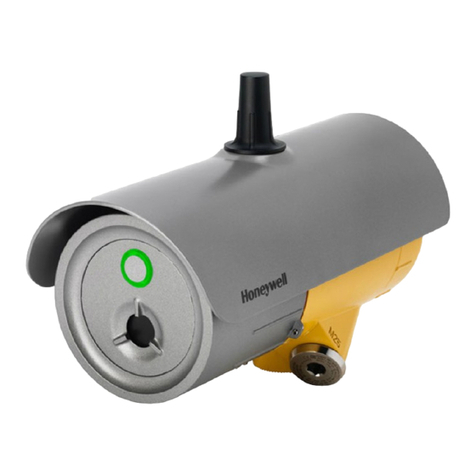
Honeywell
Honeywell SEARCHZONE SONIK SZSK-SMG Series Technical manual
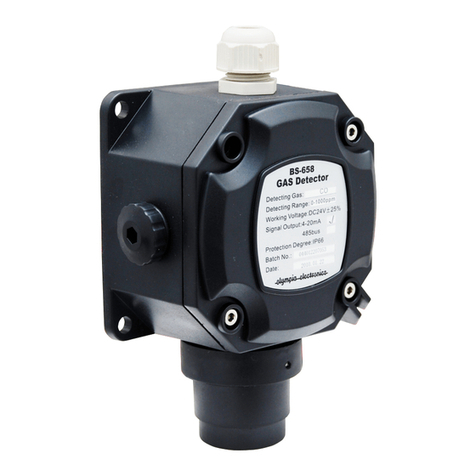
olympia electronics
olympia electronics BS-658 quick start guide
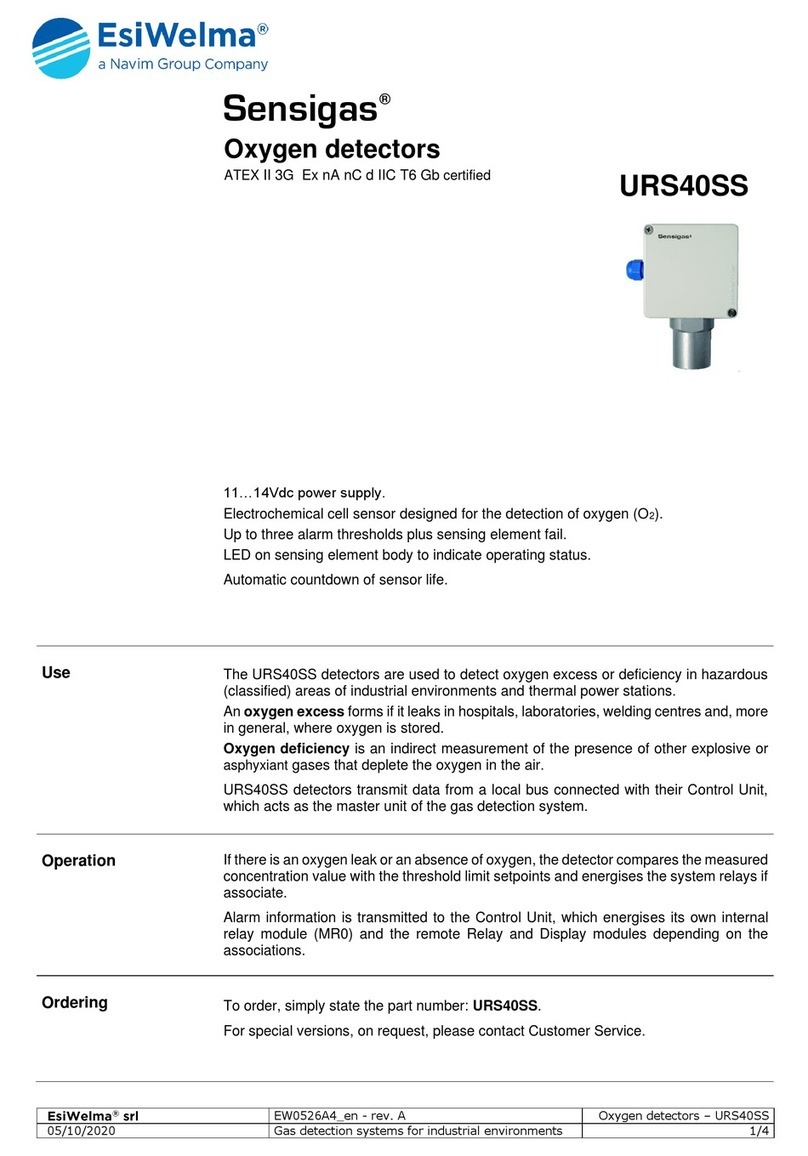
Navim Group Company
Navim Group Company EsiWelma Sensigas URS40SS manual
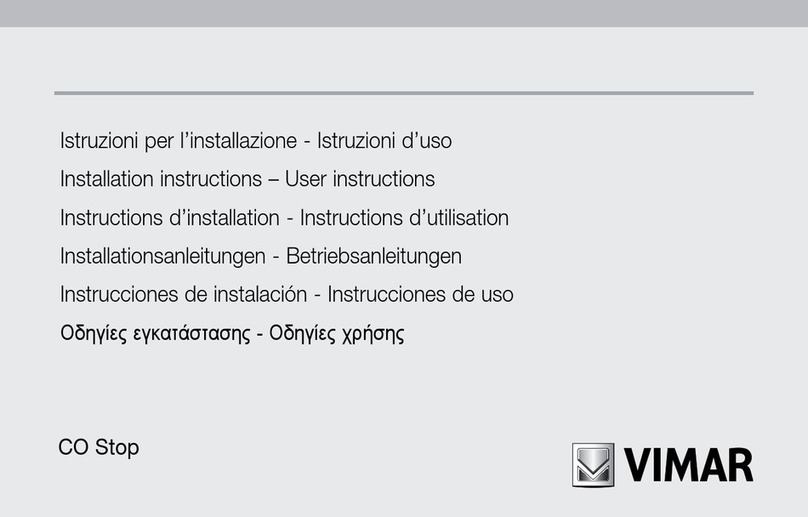
Vimar
Vimar idea CO Stop 1659 Series installation instructions

Macurco
Macurco CD Series User instructions

